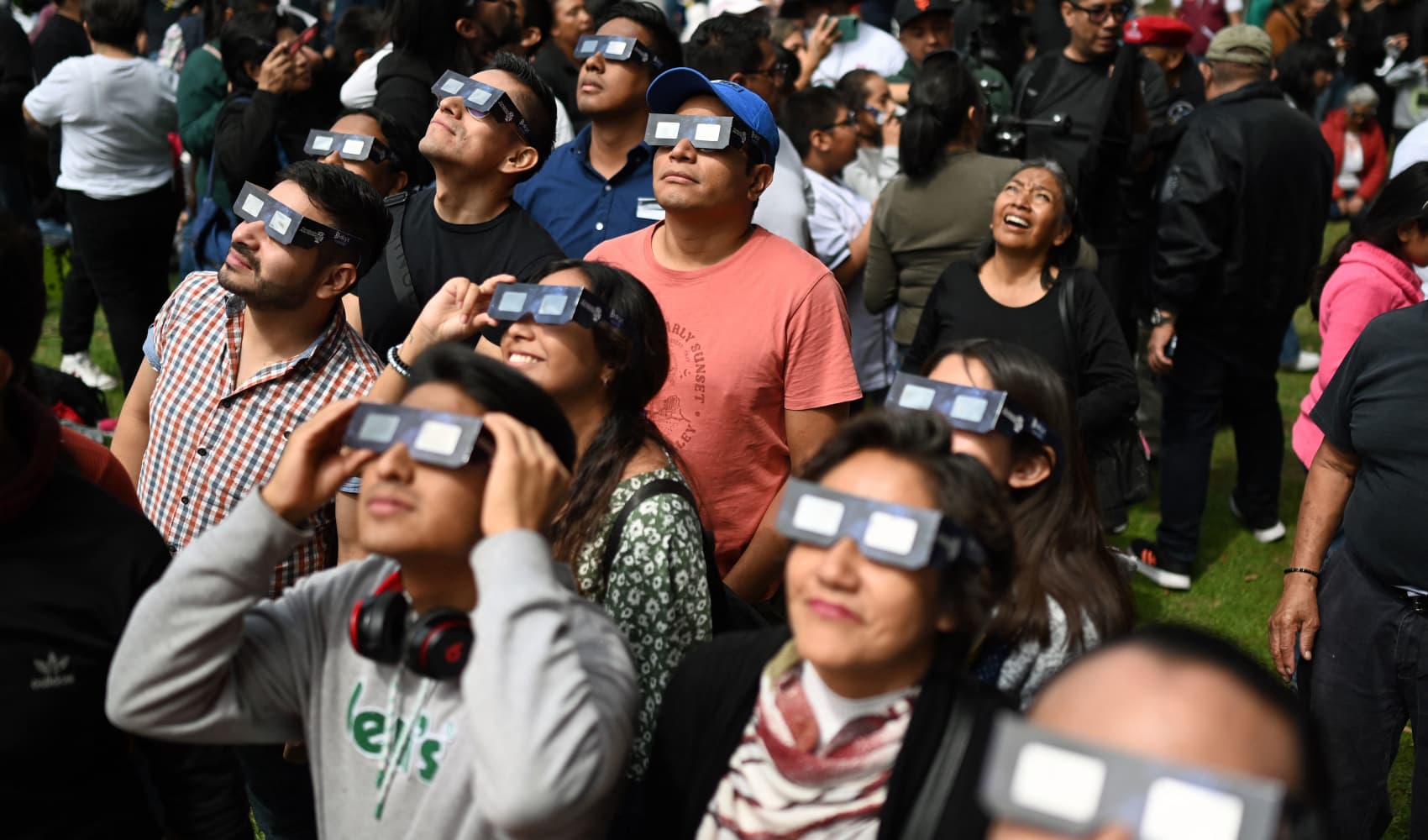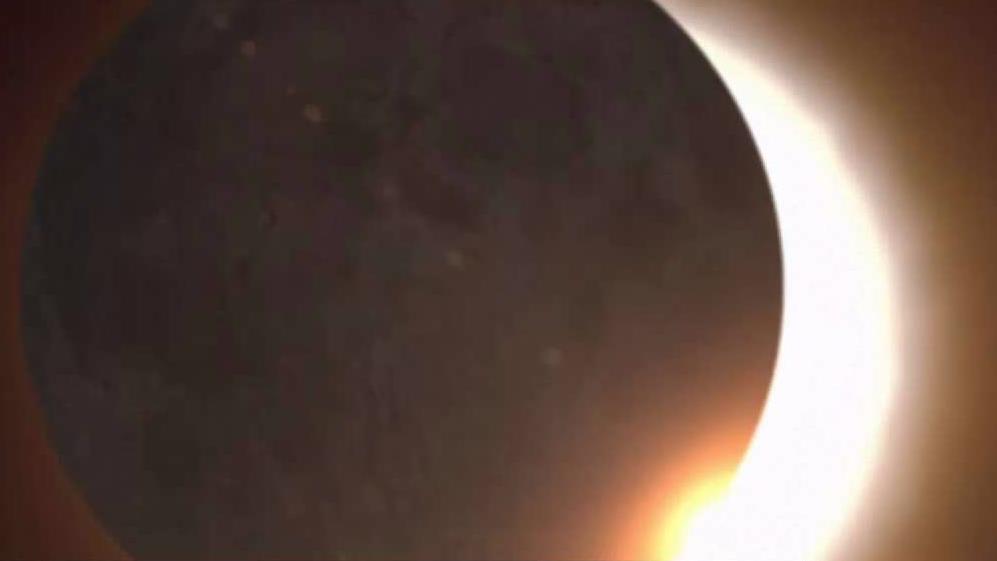Editor's Note: Live coverage of the eclipse from the path of totality begins in the player above starting at 7 a.m. Tune in for live totality starting at 1:55 p.m.
While it may seem tempting to look up at the total solar eclipse as it is happening, doing so without the proper tools can be dangerous for your eyes.
According to the Adler Planetarium, viewing the solar eclipse without proper eyewear can result in irreversible eye damage within seconds, and as your eyes lack the nerve endings to register pain as it's occurring.
Feeling out of the loop? We'll catch you up on the Chicago news you need to know. Sign up for the weekly Chicago Catch-Up newsletter here.
What's more, your pupils will be more dilated as the eclipse occurs, allowing more harmful rays to enter your eyes than on a normal sunny day.
Regular sunglasses, even very dark ones, are not safe to view the eclipse.
In 2017's eclipse, a New York woman suffered from blurred vision and permanent dark spots after staring directly into the solar eclipse.
She told doctors that she first glanced at the sun during the eclipse for 6 seconds then she borrowed a pair of what she thought were eclipse glasses and looked up at the sun for another 15 to 20 seconds. She said she viewed the eclipse with both eyes. Six weeks after the eclipse, she was still seeing dark spots in her left eye.
"It's embarrassing. People will assume I was just one of those people who stared blankly at the sun or didn't check the person with the glasses," 26-year-old Nia Payne told CNN at the time. "It's something I have to live with for the rest of my life. But it could be a whole lot worse, and I try to count my blessings."
Doctors diagnosed Payne with a rare case of acute solar retinopathy which occurs when the eye retina is severely damaged by gazing straight into the sun.
Acute solar retinopathy is caused by photochemical toxicity when light can damage the retina and underlying structures. While the eye has several ways to protect itself from such damage, certain exposures to light can still result in temporal or permanent damage, according to the NCBI.
In 1999, there were 14 recorded incidents of eyes damaged after a solar eclipse in the United Kingdom.
"The amount of light coming from the sun is intense," Michelle Nichols, director of public observing at the Adler Planetarium, told NBC Chicago. "And so you have a lot of visible light, you also have infrared light and ultraviolet light. It's the infrared and ultraviolet that you especially don't realize that your eyes are being subjected to. You don't have nerve endings on the back of your eyeball, so you could be experiencing a burn and not know it. And that burn might turn out to be permanent."
According to NASA, the only time it is safe to look at the eclipse without protection is during totality, which only some locations will experience.
The path of totality stretches from Texas to Maine and includes parts of southern Illinois.
"You can view the eclipse directly without proper eye protection only when the Moon completely obscures the Sun’s bright face – during the brief and spectacular period known as totality," NASA reports. "As soon as you see even a little bit of the bright Sun reappear after totality, immediately put your eclipse glasses back on or use a handheld solar viewer to look at the Sun."
For those in the Chicago area or anywhere else where a partial eclipse will occur, it won't be safe to remove your glasses at any point.
For those planning to see the eclipse through a camera, binoculars or telescope, those devices alone won't be enough.
Special solar filters are needed to avoid eye damage, explained Nicole Bajic, a surgical ophthalmologist with the Cleveland Clinic.
According to the National Center for Biotechnology Information, a person whose eyes are damaged by a solar eclipse will begin feeling symptoms within a few hours of the exposure.
"Damage from the eclipse is unlikely to cause pain or discomfort in your eyes because the retina does not have any pain nerves," the American Academy of Opthamology reported. "Instead, you would notice visual symptoms within four to six hours. But some may notice symptoms after 12 hours."
If you're concerned about your eyesight, the academy notes the following potential symptoms to watch for:
- Blurry vision
- Headache
- A blind spot in your central vision in one or both eyes
- Increased sensitivity to light
- Distorted vision, in which a straight line looks bent, or a door jamb looks curvy
- Changes in the way you see color, known as "dyschromatopsia"
"It's not really even obvious on an exam at first for those patients," said Derek Price, an optometrist in Fort Wayne, Indiana. "They'll come in with a complaint, they'll tell you I'm seeing a spot in my vision and that's all you get. But then over the course of the next couple months, if they come back, then you can see where it's degraded the retina itself. If it's degraded... the photoreceptors in the back of the eye could be lost forever."
While some people may recover their vision as their retina heals, many won't, according to the Baylor College of Medicine. Plus, no reliable treatment for solar retinopathy exists, making the use of proper eye protection even more important.
Solar eclipse glasses recall: Amazon, Midwestern retailers issue recall for some solar eclipse glasses
How to know if your solar eclipse glasses work
According to the Adler Planetarium, viewing the solar eclipse without proper eyewear can result in irreversible eye damage within seconds, and as your eyes lack the nerve endings to register pain as it's occurring.
What's more, your pupils will be more dilated as the eclipse occurs, allowing more harmful rays to enter your eyes than on a normal sunny day.
Regular sunglasses, even very dark ones, are not safe to view the eclipse.
With the danger of irreversible eye damage present in the event of viewing the eclipse unprotected, it's critical to ensure that the solar eclipse glasses used are not counterfeit.
But there's no real way to detect real glasses versus counterfeit ones just by looking at them.
"The glasses if they're counterfeit, they may appear fine, because maybe they're dark enough that you can that it appears like you can safely look at the sun. But what you don't know is are they letting through ultraviolet and infrared light. That's the thing that I would worry about the most," Michelle Nichols, director of public observing at the Adler Planetarium said.
Detecting real vs. fake becomes even more challenging when companies tout unproven or inaccurate safety claims.
"Just be careful and don't just assume just because it says safe glasses that they actually are because anyone can write that," she said.
If you’re still wondering how to tell if your glasses will give you the right protection, here’s a trick, according to experts:
“When you wear the glasses, you should not be able to see anything," Dr. Nina Goyal, an ophthalmologist with Rush University Medical Center told NBC Chicago. "It is a flexible resin with carbon particles infused, the only thing you should be able to see out of these is the orange glow of the sun. Don't use sunglasses, don't layer sunglasses, and don't use smoked glass."
Experts suggest purchasing solar eclipse glasses through suppliers deemed "safe" by the American Astronomical Society.
The society's list offers links to "selected suppliers of solar viewers and filters that you can be confident are safe when used properly."
"These include companies and organizations with which members of the AAS Solar Eclipse Task Force have had good experience as well as other companies and organizations that have demonstrated to our satisfaction that the products they're selling meet the safety requirements of the ISO 12312-2 international standard," the list states.
The society notes, however, that its list is not exhaustive, and glasses not listed on the site could still be safe. They do not recommend using Amazon, eBay, Temu or other online marketplaces to find lowest-priced options.
"Before you buy a solar viewer or filter online, we recommend that you make sure that (1) the seller is identified on the site and (2) the seller is listed on this page," the society states.
Here are the key take-aways for finding legitimate eclipse glasses:
- When buying eclipse glasses, look for an approved manufacturer on the astronomical society’s website and make sure the glasses have the numbers iso 1-2-3-1-2- 2 printed on the inside.
- You can find the list of Suppliers of Safe Solar Viewers & Filters here.
- If you still have your glasses from the 2017 eclipse, you might be able to reuse them. But that's only if they aren’t bent, torn, or scratched.
Some museums and stores in the Chicago area are also offering free solar eclipse glasses and viewers while supplies last.
- Solar filters: If you want to use a telescope, binoculars or camera, do not use them unprotected even if you have safe eclipse glasses. Consult the manufacturer for a proper filter to attach to your device.
- Pinhole viewer: This is a simple, inexpensive way to indirectly view the eclipse. Just take two sheets of white paper (card stock is best) and poke a hole in the middle of one sheet. With your back to the sun, hold the sheet with the hole over the other sheet and adjust them until you see a dot of light. That's the sun! As the moon travels across the sun, a crescent will appear.




